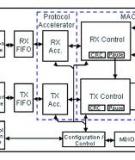
OSI Network Layer
-
Communication Architecture Strategy for connecting host computers and other communicating equipment. Defines necessary elements for data communication between devices. A communication architecture, therefore, defines a standard for the communicating hosts. A programmer formats data in a manner defined by the communication architecture and passes it on to the communication software. Separating communication functions adds flexibility, for example, we do not need to modify the entire host software to include more communication devices....
 18p
18p  doanhung_dtvtk10
doanhung_dtvtk10
 19-03-2013
19-03-2013
 69
69
 5
5
 Download
Download
-
Đợc phát triển bởi tổ chức tiêu chuẩn thế giới ISO (International Standard Organization) Gồm có 7 tầng: Tầng vật lý (Physical layer) . Tầng liên kết dữ liệu (Data link layer) Tầng mạng (Network layer) . Tầng vận chuyển (Transport layer) . Tầng giao dịch (Session layer) . Tầng trình bỡy (Presentation) . Tầng ứng dụng (Application layer) .
 13p
13p  nghiapro512
nghiapro512
 22-09-2012
22-09-2012
 133
133
 28
28
 Download
Download
-
CÂU 1: Lớp nào (Layer) trong mô hình OSI chịu trách nhiệm mã hoá (encryption) dữ liệu? A) Application B) Presentation C) Session D) Transport CÂU 2: Hãy chọn các bước hợp lý được thực hiện trong quá trình đóng gói dữ liệu (encapsulation)? A) Datasegmentspacketsframesbits B) Datapacketssegmentsframesbits C) Dataframessegmentspacketsbits D) Datasegmentsframespacketsbits
 9p
9p  vnhuy123
vnhuy123
 23-01-2011
23-01-2011
 156
156
 50
50
 Download
Download
-
Nhiệm vụ của các tầng trong mô hình OSI có thể được tóm tắt như sau: Tầng ứng dụng (Application layer – lớp 7): tầng ứng dụng quy định giao diện giữa người sử dụng và môi trường OSI, nó cung cấp các phương tiện cho người sử dụng truy cập vả sử dụng các dịch vụ của mô hình OSI. Điều khác biệt ở tầng này là nó không cung cấp dịch vụ cho bất kỳ một tầng OSI nào khác ngoại trừ tầng ứng dụng bên ngoài mô hình OSI đang hoạt động. ...
 5p
5p  anhcuong8x
anhcuong8x
 22-09-2010
22-09-2010
 1406
1406
 328
328
 Download
Download
-
Để cho các máy khác nhau địa chỉ đường mạng liên lạc được với nhau, ta phải dùng thiết bị định tuyến, là thiết bị được kết nối ở tầng thứ 3 trong mô hình OSI (Network Layer), như Router hoặc Switch L3. Do không có thiết bị như Router hay Switch L3 (Router cứng), ta dùng Server với 2 NIC và dùng dịch vụ Routing and Remote Access (RRAS) để thay thế chức năng Router (Router mềm).
 13p
13p  hoangnam232
hoangnam232
 07-06-2010
07-06-2010
 516
516
 140
140
 Download
Download
-
Thuật ngữ ICMP được viết tắt bởi Internetwork Control Message Protocol là một giao thức hoạt động trên layer 2 - Internetwork trong mô hình TCP/IP hoặc layer 3 - Network trong mô hình OSI cho phép kiểm tra và xác định lỗi của Layer 3 Internetwork trong mô hình TCP/IP bằng cách định nghĩa ra các loại thông điệp có thể sử dụng để xác định xem mạng hiện tại có thể truyền được gói tin hay không Trong thực tế, ICMP cần các thành phần của mọi gói tin IP để có thể hoạt động được. - Thỉnh...
 5p
5p  daohuongthon
daohuongthon
 21-01-2010
21-01-2010
 619
619
 89
89
 Download
Download
-
Network Layer (OSI Layer 3) The network layer is concerned with the routing of information and methods to determine paths to a destination. Information at this layer is called packets. Specifications include routing protocols, logical network addressing, and packet fragmentation. Routers operate in this layer. The CCIE lives and dies in this layer. Examples of network layer specifications are the following:
 10p
10p  thachsaudoi
thachsaudoi
 23-12-2009
23-12-2009
 90
90
 9
9
 Download
Download
-
TCP/IP Quick Guide TCP Services UDP Services IRC Internet Relay Chat DCAP Data Link Switching Client Access Protocol DHCP Dynamic Host Configuration Protocol BOOTP Bootstrap Protocol NTP Network Time Protocol TFTP Trivial File Transfer Protocol ICP Internet Cache Protocol OSI MODEL Layer 7: Application Layer HTTP HyperText Transfer Protocol Gopher TELNET Virtual Terminal POP3 Post Office Protocol Finger FTP File Transfer Protocol SMTP Simple Mail Transfer Protocol IMAP Internet Message Access Protocol NNTP Network News Transfer Protocol Defines interface to user pr...
 4p
4p  thuancrazy02
thuancrazy02
 15-12-2009
15-12-2009
 274
274
 123
123
 Download
Download
CHỦ ĐỀ BẠN MUỐN TÌM




















